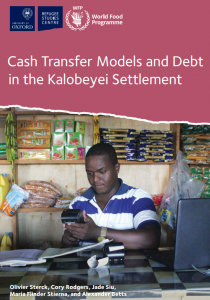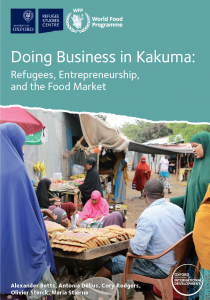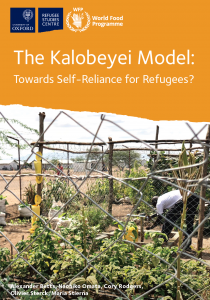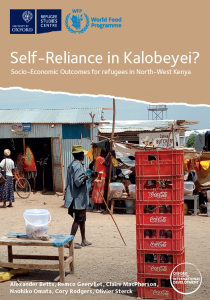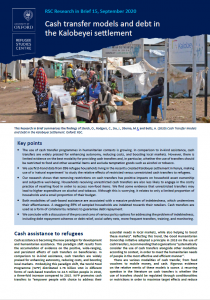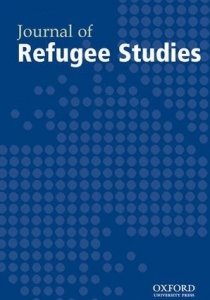alt=""
Credit: A. Betts
Kalobeyei
Designing settlements for integrated self-reliance.
Opened in the Turkana area of Kenya in 2016, the Kalobeyei settlement was designed by national and international partners as a means to promote integrated self-reliance for both refugees and the host community. It has piloted a range of market-based approaches. We examined the impact through a series of studies.
The development of the Kalobeyei settlement is guided by the Kalobeyei Integrated Social and Economic Development Programme (KISEDP), led by the Government of Kenya, the Turkana County Government, UNHCR, and partners. Located near to the existing Kakuma camps, it was originally designed to offer integrated, market-based opportunities to both refugees and the host community. Although the trajectory of the project has adapted over time, the Kalobeyei settlement offers a unique opportunity to study the creation of a newly designed and ‘innovative’ refugee settlement.
In collaboration with the World Food Programme (WFP), we have undertaken a range of studies to explore, for example, Kalobeyei’s relative impact on refugee self-reliance (compared to the nearby Kakuma camps), and to assess the impact of several innovative cash-based assistance models on both households and businesses.
The research offers crucial insights into alternatives to refugee camps, market-based approaches to refugee assistance, and cash-based interventions. It has resulted in several published reports and articles, which are described below.
Using baseline data collected in 2017, Self-Reliance in Kalobeyei? argues that, despite the unexpected arrival and settlement of large numbers of South Sudanese refugees, Kalobeyei has retained a significant commitment to self-reliance.
The settlement’s physical planning and design caters for subsistence agriculture and established designated business areas. Other innovative interventions have included cash-based food assistance called Bamba Chakula and, more recently, the world’s first ‘cash for shelter’ project, which allows refugees to be involved in the design and construction of shelter. The baseline data revealed that refugees in both Kalobeyei and Kakuma were far from self-reliant. Significant constraints remain in creating functioning labour markets, access to finance, functional infrastructure, and freedom of movement.
We returned to Kenya in 2018 to continue our three-year project. The Kalobeyei Model: Towards Self-Reliance for Refugees? covers the two waves of data collection (2017 and 2018) with the same randomly sampled respondent population. During these waves, we follow newly arrived South Sudanese refugees in both Kalobeyei and Kakuma in order to compare outcomes over time, and identify what difference the Kalobeyei settlement makes. We also follow newly arrived Ethiopian and Burundian refugees in Kalobeyei.
Indicators for self-reliance for newly arrived refugees in both settlements are poor, although we do find that Kalobeyei residents have achieved slightly higher levels of dietary diversity, food consumption, calorie-intake, food security, and interaction with the host community.
Our data shows that refugees in Kakuma and Kalobeyei remain a long way from achieving self-reliance. Despite some progress, most refugees are unable to meet their basic socio-economic needs and are dependent on aid. Our findings have sobering implications for the very concept of ‘self-reliance’ and reinforce our initial argument that the possibility for self-reliance will have to come from the large-scale macro-economic development of the wider sub-county of Turkana West.
In 2018 we also carried out a business survey with food retailers to assess the impact of the 'Bamba Chakula' model of electronic food transfers and business contracts.
The Bamba Chakula programme is a cash-based intervention implemented by WFP in 2015 as an alternative to in-kind food assistance, which represents a transitional arrangement between in-kind and full-cash assistance. At the time of our data collection, refugees in Kalobeyei received almost all their food through Bamba Chakula. In Kakuma, only 30% of food assistance was received through this programme, with the rest being distributed through in-kind assistance.
Understanding the Bamba Chakula experience offers insights of wider relevance into how markets emerge and develop in refugee camps and settlements, the process of transition from in-kind to cash-based assistance, and what determines entrepreneurial success in a refugee camp. It also poses challenging questions about the appropriate role for humanitarian organisations in regulating markets. We offer a series of practical recommendations relating to the transition to cash assistance, the potential of Bamba Chakula to be replicated elsewhere, and the relationship between self-reliance, entrepreneurship, and food assistance.
In June 2019, Bamba Chakula transfers were replaced by unrestricted cash transfers, paid directly into the bank accounts for about 1,050 households in Village 3. The settlements remaining 7,000 households continued to benefit from Bamba Chakula. Our third wave of data collection makes use of this ‘natural experiment’ to study the relative effects of restricted versus unrestricted cash transfers.
Cash Transfer Models and Debt in the Kalobeyei Settlement reveals that the switch to unrestricted cash transfers had robustly positive effects on household asset accumulation and subjective well-being. They are also less likely to engage in the highly inefficient practice of reselling food in order to access non-food items. However, it should be noted that only a limited share of households reported benefitting from the switch, with the majority of refugees highlighting that indebtedness meant that these benefits had gone unrealised.
Recognising the role of credit and debt in consumer-retailer relations in Kalobeyei has major implications for future cash assistance programmes. This report discusses the pros and cons of various policy options for addressing the problems of indebtedness.
Our findings are also summarised in a research breif entitled Cash Transfer Models and Debt in the Kalobeyei Settlement.

